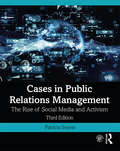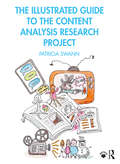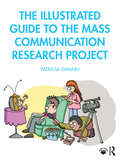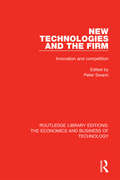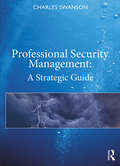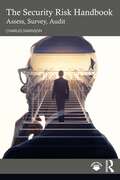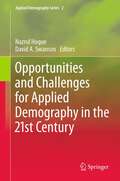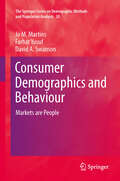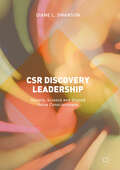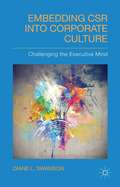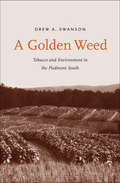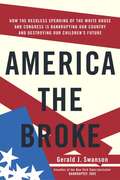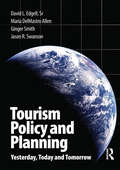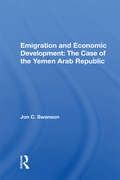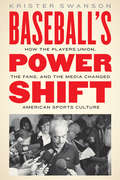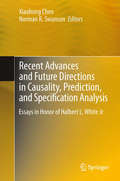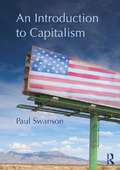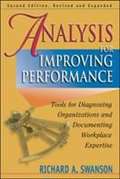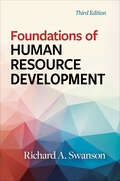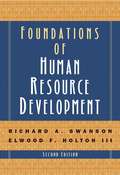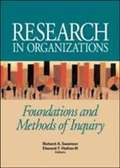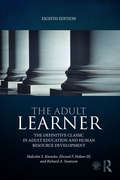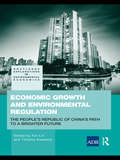- Table View
- List View
Cases in Public Relations Management: The Rise of Social Media and Activism
by Patricia SwannNow in its third edition, Cases in Public Relations Management uses recent cases in strategic communication designed to encourage discussion, debate, and exploration of the options available to today's strategic public relations manager, with the help of extensive supplemental materials. Key features of this text include coverage of the latest controversies in current events, discussion of the ethical issues that have made headlines in recent years, and strategies used by public relations practitioners. The problem-based case study approach encourages readers to assess what they know about communication theory, the public relations process, and management practices. New to the third edition: Eighteen new cases including Snap, Wells Fargo, SeaWorld, United Airlines, and Starbucks. Additional emphasis on social media and social responsibility for communication management today. End-of-chapter activities that reinforce concepts. Developed for advanced students in strategic communication and public relations, this book prepares them for their future careers as communication and public relations professionals. The new edition features a fully enhanced companion website that includes resources for both instructors and students. Instructors will find PowerPoint Lecture Slides, Case Supplements, Instructor Guides, and Answer Keys for Quizzes and End-of-Chapter Activities. Students will benefit from Quizzes, a Glossary, and Case Supplements.
The Illustrated Guide to the Content Analysis Research Project
by Patricia SwannThe Illustrated Guide to the Content Analysis Research Project makes mass media research more accessible through an informal and humorous student-centered approach. Author Patricia Swann provides a colorful, step-by-step guide to developing a typical mass media research project using the content analysis method. The fundamental elements of this research method are presented in plainspoken language perfect for undergraduates and new researchers, complete with engaging illustrations and an informal narrative that tackle students’ most common sticking-points when learning and applying research methods. Supplemented by online worksheets for further reflection, this book is an excellent companion to research-centered courses in mass media, communication studies, marketing, and public relations at the introductory level.
The Illustrated Guide to the Mass Communication Research Project
by Patricia SwannThis book makes mass communication research projects more accessible to the new student researcher through a balance between an academically rigorous guide and an informal and humorous student-centered approach. The Illustrated Guide to the Mass Communication Research Project’s unique, visual approach brings to life concepts and tactics under discussion through vivid illustrations. The book follows the universal format of the academic research paper: abstract, introduction, literature review, methodology, hypotheses/research questions, quantitative and qualitative analysis/findings, discussion, and conclusion. It guides the reader through using key methods central to much of mass communication research: observation, interviews, focus groups, case studies, content analysis, surveys, experiments, and sampling. Each chapter contains examples of the segment under discussion, using excerpted research studies that provide writing models for the student’s own research report. Ideal for students in research-centered courses in mass media, communication studies, marketing, and public relations, whether at the undergraduate or graduate level, this text will continue to serve as a valuable resource into a future communications and marketing career. Online resources are provided to support the book: examples of an in-depth interview guide, a focus group moderator guide, a content analysis coding form, observation field notes and an experiment cover story; templates for a personal SWOT analysis and an informed consent form; a research topic worksheet; a literature review matrix; and coding exercises. Please visit www.routledge.com/9781032080758.
New Technologies and the Firm: Innovation and Competition (Routledge Library Editions: The Economics and Business of Technology #48)
by Peter SwannOriginally published in 1993 this book presents the findings of 14 teams involved in a research initiative to examine the initiation and resonse to innovation in firms. It draws together the many strands which were discovered to influence the successful generation and adoption of new technologies. The core issues in technology management are looked at, including skills and expertise, markets and marketing, finance and the issue of technology collaboration both on a domestic and international basis. Technology is shown to be at the very heart of corporate strategy and policy formation.
Professional Security Management: A Strategic Guide
by Charles SwansonHistorically, security managers have tended to be sourced from either the armed forces or law enforcement. But the increasing complexity of the organisations employing them, along with the technologies employed by them, is forcing an evolution and expansion of the role, and security managers must meet this challenge in order to succeed in their field and protect the assets of their employers. Risk management, crisis management, continuity management, strategic business operations, data security, IT, and business communications all fall under the purview of the security manager. This book is a guide to meeting those challenges, providing the security manager with the essential skill set and knowledge base to meet the challenges faced in contemporary, international, or tech-oriented businesses. It covers the basics of strategy, risk, and technology from the perspective of the security manager, focussing only on the 'need to know'. The reader will benefit from an understanding of how risk management aligns its functional aims with the strategic goals and operations of the organisation. This essential book supports professional vocational accreditation and qualifications, such as the Chartered Security Professional (CSyP) or Certified Protection Professional (CPP), and advises on pathways to higher education qualifications in the fields of security and risk management. It is ideal for any risk manager looking to further their training and development, as well as being complementary for risk and security management programs with a focus on practice.
The Security Risk Handbook: Assess, Survey, Audit
by Charles SwansonThe Security Risk Handbook assists businesses that need to be able to carry out effective security risk assessments, security surveys, and security audits. It provides guidelines and standardised detailed processes and procedures for carrying out all three stages of the security journey: assess, survey, and audit. Packed with tools and templates, the book is extremely practical. At the end of each explanatory chapter, a unique case study can be examined by the reader in the areas of risk assessment, security survey, and security audit. This book also highlights the commercial and reputational benefits of rigorous risk management procedures. It can be applied to corporate security, retail security, critical national infrastructure security, maritime security, aviation security, counter-terrorism, and executive and close protection. This text is relevant to security professionals across all key sectors: corporate security, retail security, critical national infrastructure security, maritime security, aviation security, counter-terrorism, and executive and close protection. It will also be useful to health and safety managers, operations managers, facilities managers, and logistics professionals whose remit is to ensure security across an organisation or function.
Police Administration: Structures, Processes, and Behaviors (Ninth Edition)
by Charles R. Swanson Leonard Territo Robert W. TaylorThis edition blends a comprehensive introduction to police administration with key supporting details.
Police Administration: Structures, Processes, and Behavior (8th Edition)
by Charles R. Swanson Leonard Territo Robert W. TaylorThis best-selling text presents a vivid introduction to police organizations that focuses on the procedures, politics and human relations issues police supervisors and administrators must understand in order to succeed. Building on the authors' decades of collective experience in law enforcement, training, and teaching, Police Administration 8e is recognized by both the academic and law enforcement communities as the authoritative treatment of this topic. Fully updated in this edition, it includes the latest on the evolution of American policing, the organization and the leader, the management of police organizations, and modern organizational issues.
Opportunities and Challenges for Applied Demography in the 21st Century
by David A. Swanson Nazrul HoqueApplied demography continues its rapid pace of evolution in concert with the emerging trends of the 21st century. One significant area of change is the extension of applied demography beyond the United States; this book includes material dealing with applied demography in Australia, Canada, Estonia, and Mexico. Opportunities and Challenges for Applied Demography in the 21st Century presents a score of selected papers from the second post-2000 national conference on Applied Demography, held in San Antonio, Texas, in January, 2010, under the sponsorship of the Institute for Demographic and Socioeconomic Research at The University of Texas at San Antonio. Coverage includes the assembly of data by government agencies, with a focus on issues facing the United States; demographic issues associated with globalization; business demography and health demography, as well as a section examining methodological advances in the areas of estimation and projection.
Consumer Demographics and Behaviour: Markets are People (The Springer Series on Demographic Methods and Population Analysis #30)
by David A. Swanson Farhat Yusuf Jo M. MartinsThis is the book that market strategists have been waiting for to position themselves in global markets and take advantage of the opportunities that demographic bonuses and deficits offer to them and their products. It is also a book for teachers and students of consumer behaviour to grasp the importance of the life cycle as a framework that shapes the demand for goods and services determined by changes in social, economic and physical functioning. It gives insights into gendered consumer behaviour and cohort effects. It presents a range of views on consumer behaviour and how demographic perspectives enhance these perspectives. The book offers conceptual and analytical tools that can be used in the assessment of population characteristics as determinants of market size, composition and potential for a variety of products. It offers organising frameworks as well as empirical evidence of consumer behaviour in clusters of markets, with different rates of population growth and age distribution that affect consumers' priorities and demand for basic and progressive commodities. The book shows commonalities as well as differences in consumer behaviour arising from different cultures and social customs. It uses analytical tools that are explained and accessible to readers with a range of competences. It is a book that can give a better understanding of consumer behaviour and market opportunities to the practitioner. It can also be used for the instruction of students in demography, consumer behaviour and marketing.
CSR Discovery Leadership: Society, Science and Shared Value Consciousness
by Diane L. SwansonThis book argues that separation consciousness has kept a collective demand for corporate social responsibility at bay, even providing justification for business to neglect society. Yet there are signs that separation consciousness is being replaced with the expectation that businesses engage in symbiotic relationships with stakeholders that yield triple bottom line benefits. The potential for business to enact this social contract depends largely on the ability of top executives to discover how to activate the organizational values that make such benefits possible. The author argues that the required mind-set for this task bears a strong resemblance to the scientific discovery mentality, and that if executives were to embed this mentality in organizational decision making, shared consciousness between firms and stakeholders of the values that support corporate responsibility is feasible. CSR Discovery Leadership examines this prospect of shared value consciousness, a new frontier for CSR leadership.
Embedding CSR into Corporate Culture
by Diane L. SwansonEmbedding CSR into Corporate Culture demonstrates that a new frontier for corporate social responsibility is possible in theory and practice. The key idea - discovery leadership - enables corporate managers to deal effectively with problems, issues, and value clashes occurring at the corporation-society interface.
A Golden Weed
by Dr Drew A. SwansonDrew A. Swanson has written an "environmental" history about a crop of great historical and economic significance: American tobacco. A preferred agricultural product for much of the South, the tobacco plant would ultimately degrade the land that nurtured it, but as the author provocatively argues, the choice of crop initially made perfect agrarian as well as financial sense for southern planters. Swanson, who brings to his narrative the experience of having grown up on a working Virginia tobacco farm, explores how one attempt at agricultural permanence went seriously awry. He weaves together social, agricultural, and cultural history of the Piedmont region and illustrates how ideas about race and landscape management became entangled under slavery and afterward. Challenging long-held perceptions, this innovative study examines not only the material relationships that connected crop, land, and people but also the justifications that encouraged tobacco farming in the region.
America the Broke
by Gerald J. Swanson“One day soon, our government will suddenly run out of cash, unable to meet its payments, leaving the United States as bankrupt as any banana republic. We are far more vulnerable than most Americans realize. . . With a debt of $7. 3 trillion, if interest rates were to hit the levels we saw 20 years ago, it would take every nickel collected in income taxes just to pay the interest on our existing debt. There would be no money left for defense, or homeland security, or education, or Social Security. This scenario is hardly fiction. That the United States of America can literally go broke is no longer a fantasy but likelihood—unless we stop the train now speeding us to Armageddon. If we do not get our financial house in order, and soon, our great nation will collapse under the weight of its financial obligations. I believe we can prevent the catastrophe. But time is short. In the final reckoning, it’s up to us to do what’s needed to save America’s future. ”—fromAmerica the BrokeThe dirty little secret that neither George W. Bush nor Congress are willing to confront—that America’s reckless spending, disastrous deficits, and exploding debt are speeding our great nation to financial ruin. Imagine a world in which you lose your job because your company goes under, your retirement money disappears, the value of your home tumbles overnight, your bank stops allowing cash withdrawals, and your ATM card is canceled. The price of groceries has risen so fast that you don’t have the money to pay for them at the check-out counter . . . and the country is bankrupt. That is exactly the future that economist Gerald J. Swanson sees America hurtling toward—unless we rein in our country’s reckless spending. InAmerica the Broke, Swanson, coauthor of the runawayNew York TimesbestsellerBankruptcy 1995, argues that the United States is on the brink of financial collapse. Thanks to George W. Bush’s two tax cuts, the White House and Congress’ escalation of domestic spending, two wars, and an economic recession, what was a $200 billion annual surplus three years ago under Bill Clinton has become a river of red ink. The White House’s official projected deficit for 2004 is $521 billion—the largest deficit in U. S. history. With a national debt spiraling upward of $7. 3 trillion, a huge trade deficit, and personal debt at an all-time high, we are standing at the edge of a financial abyss that could undermine the financial security of our families and our children’s children. “Deficits don’t matter,” claim Vice President Dick Cheney and other members of the Bush Administration. But the facts revealed inAmerica the Brokepaint an alarming picture. Next year’s projected deficit will exceed the amount all our cities spend on police, fire protection, medical care, and every other civil service in an entire year. It is more than we could save from abolishing Medicare and Medicaid completely. Therealdeficit—the deficit the government doesn’t want you to know about—including the hidden funds we “borrow” from Social Security is nearly $1trillion. Rising interest rates alone could trigger staggering payments on our skyrocketing debt, soaking up every dollar the government takes in, leaving America bankrupt. What does this mean for you and me? If the dollar goes into free fall, banks could close, businesses go bankrupt, real estate values crumble, and middle-class families could lose everything they own. But there is hope. We can save ourselves—ifwe demand that our political leaders act now to eliminate the deficit and reduce the debt. In a year of deficit de
Tourism Policy and Planning: Yesterday, Today, And Tomorrow
by Jason Swanson Ginger Smith Maria Delmastro Allen David Edgell Sr.For many communities and countries throughout the world tourism is the most valuable industry. Economic changes taking place in China, India, and the United States (with almost 3 billion people, half the world's population), for example, will have major impacts on the global tourism markets of tomorrow. Social-cultural changes in Europe, with borderless tourism crossings and a common currency, are increasing opportunities for tourism growth. East Asia and the Pacific Rim are experiencing unprecedented growth and change in tourism. From the perspective of economic policy, tourism for local communities is a vital economic development tool producing income, creating jobs, spawning new businesses, spurring economic development, promoting economic diversification, developing new products, and contributing to economic integration. If local and national governments are committed to broad based tourism policies, then tourism will provide its citizens with a higher quality of life while it generates sustained economic, environmental, and social benefits. The wellspring to future growth for tourism throughout the world is a commitment toward good policy. Governments, the private sector, and not-for-profit agencies must be the leaders in a sustainable tourism policy that transcends the economic benefits and embraces environmental and cultural interests as well. Tourism Policy and Planning: Yesterday, Today, and Tomorrow addresses key ingredients for positive tourism policies and planning that will lead this generation and the next toward a greater quality of life resulting from tourism growth. The aim of this book is to provide government policy-makers (at all levels), business leaders, not-for-profit executives, university professors, students, tourism industry managers, and the general public with an introduction and examination of important policy and planning issues in tourism.
Emigration And Economic Development: The Case Of The Yemen Arab Republic
by Jon C. SwansonAlthough social scientists tend to agree that emigration improves the standard of living of migrants and their families, research suggests that more generally it has a neutral or even negative effect on economic development in the home country. The Yemen Arab Republic is a case in point: while living standards there have improved with emigration, t
Baseball's Power Shift: How the Players Union, the Fans, and the Media Changed American Sports Culture
by Krister SwansonFrom Major League Baseball’s inception in the 1880s through World War II, team owners enjoyed monopolistic control of the industry. Despite the players’ desire to form a viable union, every attempt to do so failed. The labor consciousness of baseball players lagged behind that of workers in other industries, and the public was largely in the dark about labor practices in baseball. In the mid-1960s, star players Sandy Koufax and Don Drysdale staged a joint holdout for multiyear contracts and much higher salaries. Their holdout quickly drew support from the public; for the first time, owners realized they could ill afford to alienate fans, their primary source of revenue. Baseball’s Power Shift chronicles the growth and development of the union movement in Major League Baseball and the key role of the press and public opinion in the players’ successes and failures in labor-management relations. Swanson focuses on the most turbulent years, 1966 to 1981, which saw the birth of the Major League Baseball Players Association as well as three strikes, two lockouts, Curt Flood’s challenge to the reserve clause in the Supreme Court, and the emergence of full free agency. To defeat the owners, the players’ union needed support from the press, and perhaps more importantly, the public. With the public on their side, the players ushered in a new era in professional sports when salaries skyrocketed and fans began to care as much about the business dealings of their favorite team as they do about wins and losses. Swanson shows how fans and the media became key players in baseball's labor wars and paved the way for the explosive growth in the American sports economy.
Recent Advances and Future Directions in Causality, Prediction, and Specification Analysis
by Norman R. Swanson Xiaohong ChenThis book is a collection of articles that present the most recent cutting edge results on specification and estimation of economic models written by a number of the world's foremost leaders in the fields of theoretical and methodological econometrics. Recent advances in asymptotic approximation theory, including the use of higher order asymptotics for things like estimator bias correction, and the use of various expansion and other theoretical tools for the development of bootstrap techniques designed for implementation when carrying out inference are at the forefront of theoretical development in the field of econometrics. One important feature of these advances in the theory of econometrics is that they are being seamlessly and almost immediately incorporated into the "empirical toolbox" that applied practitioners use when actually constructing models using data, for the purposes of both prediction and policy analysis and the more theoretically targeted chapters in the book will discuss these developments. Turning now to empirical methodology, chapters on prediction methodology will focus on macroeconomic and financial applications, such as the construction of diffusion index models for forecasting with very large numbers of variables, and the construction of data samples that result in optimal predictive accuracy tests when comparing alternative prediction models. Chapters carefully outline how applied practitioners can correctly implement the latest theoretical refinements in model specification in order to "build" the best models using large-scale and traditional datasets, making the book of interest to a broad readership of economists from theoretical econometricians to applied economic practitioners.
An Introduction to Capitalism
by Paul SwansonEmbedded in an historical account of the development of U.S. capitalism up to the present day, this book gives the reader a thorough description of the major aspects of the U.S. economy, as well as a theoretical understanding of the overall economy. A particular focus of this book is how free markets work in capitalism and the interrelationship between markets and the government. Of particular interest in the current economic situation is the question of what can the government do to get the economy going again. Underlying the standard economics text today is the fundamental belief that leaving markets as free as possible will lead to the ideal economy. Directly opposing this approach, this book takes a critical stance toward free markets. Rather than viewing markets as the ideal solution to almost all economic problems, this book argues that markets are not always the answer. On the contrary, they are often the problem, and must be corrected by government action. Related to this critical stance, and in a further departure from current economics texts, this book takes an explicitly Keynesian approach to the macro-economy. Rejecting the free market approach which dominates both micro- and macro-economics today, this book offers a fresh perspective on economics and the economy today.
Analysis for Improving Performance: Tools for Diagnosing Organizations and Documenting Workplace Expertise (2nd edition)
by Richard A. SwansonSwanson describes a systematic approach that helps program developers and managers to lay the groundwork necessary for ensuring the success of organizational performance improvement efforts. The focus is on the analysis phase, during which current organizational performance is diagnosed and workplace expertise is documented. A new chapter on documenting and improving work processes has been added for the second edition. Swanson teaches human resource development at the U. of Texas at Tyler. Annotation ©2007 Book News, Inc., Portland, OR (booknews.com)
Foundations of Human Resource Development: Profit for Your Workplace and the Environment
by Richard A SwansonThe third edition of this classic is a must-have text for the human resource development (HRD) profession. It has with brand-new material on the impact of technology, globalization, and emerging business trends on HRD practice.Human Resource Development is a large field of practice but a relatively young academic discipline. For the last two decades, Foundations of Human Resource Development has fulfilled the field's need for a complete and thoughtful foundational text. This essential text provides an up-to-date overview of the HRD profession, along with the terminology and processes required for sound HRD research and practice. Readers will gain a basic understanding of• HRD models and theories that support best practice • History and philosophical foundations of the field• HRD's role in learning, performance, and change in organizations This new edition has been updated throughout and contains new chapters on assessment, technology, globalization, and future challenges. Examples of best practices are included, along with variations in core thinking, processes, interventions, tools, and much more. This must-have reference will help both practitioners and academics add clarity to their professional journeys.
Foundations of Human Resource Development (2nd edition)
by Richard A. Swanson Elwood F. Holton IIIFor students, researchers, and practitioners, Swanson (human resource development, U. of Texas at Tyler) and Holton (human resource and leadership development, Louisiana State U.) provide a textbook on human resource development (HRD) that focuses on the fundamentals and foundations of practice that does not focus on best practices. Instead, it addresses models, processes, history, theoretical and philosophical foundations, learning and performance paradigms and models, the role of HRD in high-level organizational and systems-level issues, and training and development and organization development. This edition has been revised, updated, and expanded to include new chapters on component HRD theories, policy and planning, technology, and globalization. Annotation ©2009 Book News, Inc., Portland, OR (booknews.com)
Research in Organizations: Foundation and Methods of Inquiry
by Richard A. Swanson Elwood F. Holton IIIResearch in Organizations offers a holistic perspective of the subject that embraces quantitative, qualitative, and mixed-methodology research procedures.
The Adult Learner: The definitive classic in adult education and human resource development
by Richard Swanson Elwood Holton Malcolm KnowlesHow do you tailor education to the learning needs of adults? Do they learn differently from children? How does their life experience inform their learning processes? These were the questions at the heart of Malcolm Knowles’s pioneering theory of andragogy which transformed education theory in the 1970s. The resulting principles of a self-directed, experiential, problem-centered approach to learning have been hugely influential and are still the basis of the learning practices we use today. Understanding these principles is the cornerstone of increasing motivation and enabling adult learners to achieve. This eighth edition has been thoughtfully updated in terms of structure, content, and style. On top of this, online material and added chapter-level reflection questions make this classic text more accessible than ever. The new edition includes: Two new chapters: Neuroscience and Andragogy, and Information Technology and Learning. Updates throughout the book to reflect the very latest advancements in the field. A companion website with instructor aids for each chapter. If you are a researcher, practitioner or student in education, an adult learning practitioner, training manager, or involved in human resource development, this is the definitive book in adult learning that you should not be without.
Economic Growth and Environmental Regulation: China's Path to a Brighter Future (Routledge Explorations In Environmental Economics Ser. #20)
by Tim Swanson Tun LinThis volume assembles a group of eminent scholars to look at the problem of growth and environment from the perspective of environmental regulation. The questions addressed are: How does economic growth interact with regulation, and what are the best approaches to regulation in use today? The context for the volume is the current situation in China, where twenty years of rapid growth have created a situation in which there are both demands for environmental regulation and needs for choosing a future development path. The advent of "A Macro-Environmental Strategy" for China presents an opportunity to ask how and why China should introduce regulation into its management of its development. The volume includes contributions from leading Chinese experts and established environmental economists from other countries including Timo Goeschl, Ben Groom and Andreas Kontoleon. The volume looks at both the demand side of environmental regulation and the supply side. The demand side of regulatory intervention examines how regulation operates to supplement existing resource-allocation mechanisms, via effective demand aggregation and implementation mechanisms. The supply side of regulation examines how regulation operates to guide industrial growth down particular pathways, in the pursuit of managed development. Both sides of environmental regulation involve the important issue of implementation and enforcement. This volume will be of most value to academics and scholars of environmental economics, growth economics, the Chinese economy and policy-makers of environmental regulations.
